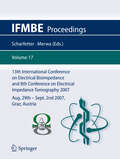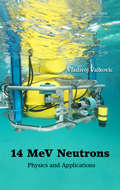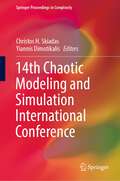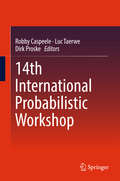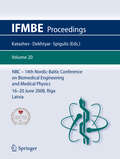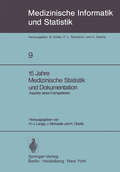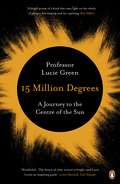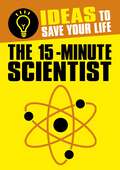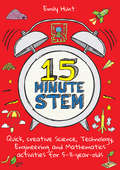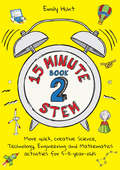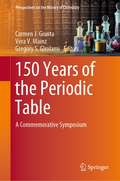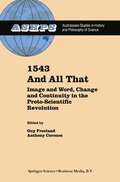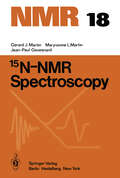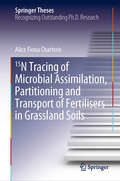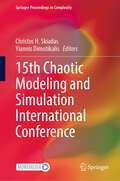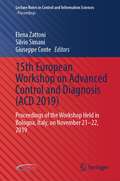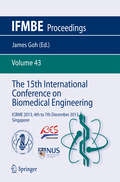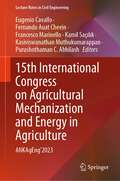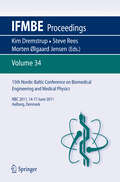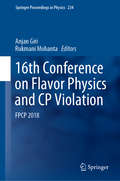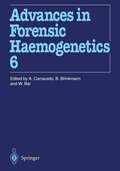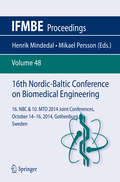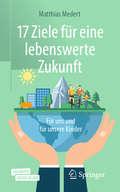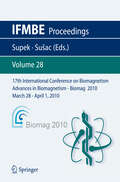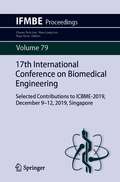- Table View
- List View
13th International Conference on Electrical Bioimpedance and 8th Conference on Electrical Impedance Tomography 2007: ICEBI 2007, August 29th - September 2nd 2007, Graz, Austria (IFMBE Proceedings #17)
by Hermann Scharfetter Robert MerwaThis book presents the proceedings of the 13th International Conference on Electrical Bioimpedance, ICEBI 2007, combined with the 8th Conference on Electrical Impedance Tomography, held at the Graz University of Technology in Graz, Austria, in August 2007.
14 MeV Neutrons: Physics and Applications
by Vladivoj ValkovicDespite the often difficult and time-consuming effort of performing experiments with fast (14 MeV) neutrons, these neutrons can offer special insight into nucleus and other materials because of the absence of charge. 14 MeV Neutrons: Physics and Applications explores fast neutrons in basic science and applications to problems in medicine, the envir
14th Chaotic Modeling and Simulation International Conference (Springer Proceedings in Complexity)
by Christos H. Skiadas Yiannis DimotikalisGathering the proceedings of the 14th CHAOS2021 International Conference, this book highlights recent developments in nonlinear, dynamical and complex systems. The conference was intended to provide an essential forum for Scientists and Engineers to exchange ideas, methods, and techniques in the field of Nonlinear Dynamics, Chaos, Fractals and their applications in General Science and the Engineering Sciences. The respective chapters address key methods, empirical data and computer techniques, as well as major theoretical advances in the applied nonlinear field. Beyond showcasing the state of the art, the book will help academic and industrial researchers alike apply chaotic theory in their studies.Chapter "On the Origin of the Universe: Chaos or Cosmos" is available open access under a Creative Commons Attribution 4.0 International License via link.springer.com
14th International Probabilistic Workshop
by Robby Caspeele, Luc Taerwe and Dirk ProskeThis book presents the proceedings of the 14th International Probabilistic Workshop that was held in Ghent, Belgium in December 2016. Probabilistic methods are currently of crucial importance for research and developments in the field of engineering, which face challenges presented by new materials and technologies and rapidly changing societal needs and values. Contemporary needs related to, for example, performance-based design, service-life design, life-cycle analysis, product optimization, assessment of existing structures and structural robustness give rise to new developments as well as accurate and practically applicable probabilistic and statistical engineering methods to support these developments. These proceedings are a valuable resource for anyone interested in contemporary developments in the field of probabilistic engineering applications.
14th Nordic-Baltic Conference on Biomedical Engineering and Medical Physics: NBC 2008. 16-20 June 2008. Riga, Latvia (IFMBE Proceedings #20)
by Alexei Katashev Yuri Dekhtyar Janis Spigulis14th Nordic – Baltic Conference on Biomedical Engineering and Medical Physics – NBC-2008 – brought together scientists not only from the Nordic – Baltic region, but from the entire world. This volume presents the Proceedings of this international conference, jointly organized by the Latvian Medical Engineering and Physics Society, Riga Technical University and University of Latvia in close cooperation with International Federation of Medical and Biological Engineering (IFMBE) The topics covered by the Conference Proceedings include: Biomaterials and Tissue Engineering; Biomechanics, Artificial Organs, Implants and Rehabilitation; Biomedical Instrumentation and Measurements, Biosensors and Transducers; Biomedical Optics and Lasers; Healthcare Management, Education and Training; Information Technology to Health; Medical Imaging, Telemedicine and E-Health; Medical Physics; Micro- and Nanoobjects, Nanostructured Systems, Biophysics
15 Jahre Medizinische Statistik und Dokumentation: Aspekte eines Fachgebietes (Medizinische Informatik, Biometrie und Epidemiologie #9)
by H. J Lange J. Michaelis K. Überla15 Million Degrees: A Journey to the Centre of the Sun
by Professor Lucie Green110 times wider than Earth; 15 million degrees at its core; an atmosphere so huge that Earth is actually within it: come and meet the star of our solar systemLight takes eight minutes to reach Earth from the surface of the Sun. But its journey within the Sun takes hundreds of thousands of years. What is going on in there? What are light and heat? How does the Sun produce them and how on earth did scientists discover this? In this astonishing and enlightening adventure, you'll travel millions of miles from inside the Sun to its surface and to Earth, where the light at the end of its journey is allowing you to read right now. You'll discover how the Sun works (including what it sounds like), the latest research in solar physics and how a solar storm could threaten everything we know. And you'll meet the groundbreaking scientists, including the author, who pieced this extraordinary story together.
The 15-Minute Scientist
by Anne RooneySome of life's most fascinating and topical questions lie within the complex realm of science. From the serious and practical to the quirky and bizarre, 15-Minute Scientist answers these questions in an easy-to-understand manner. Ranging across biology, physics, astronomy, chemistry and geology, these questions include: • Why don't we go to Mars? • Is this the end for antibiotics? • Do we all see the same colours? • What's happening with the climate? • What is the most economical way to drive a car? Including pictures, diagrams and useful fact boxes, this riveting guide to science is perfect for the non-expert. Many of these answers have implications for everyday living and may change the way you perceive the future. ABOUT THE SERIES: Ideas to Save Your Life takes concepts from academic subjects and applies them to your everyday life. Written in an engaging Q&A format, these books will help you answer fundamental questions and improve your day-to-day living.
15-Minute STEM: Quick, creative science, technology, engineering and mathematics activities for 5-11-year-olds
by Emily HuntEmily Hunt’s 15-Minute STEM: Quick, creative science, technology, engineering and mathematics activities for 5–11-year-olds offers an exciting collection of 40 tried-and-tested, easy-to-resource STEM activities designed to engage and inspire young learners. From caring for our environment to the digital revolution, the demand for STEM skills is huge and is only set to grow. STEM is therefore an important priority area in modern education, leaving many teachers and parents asking questions such as ‘How do I fit STEM education into my day?’ and ‘What kind of activities should I be exploring?’ Enter 15-Minute STEM with the answers … This innovative resource has been designed to reassure teachers and parents that they don’t need to be experts to deliver high-quality STEM education. Each of the 40 activities includes step-by-step instructions, takes just 15 minutes to complete and can be resourced from everyday materials found in the classroom or at home. This means that, with minimal preparation, teachers can slot these cross-curricular activities into an otherwise busy day, broadening their pupils’ learning at no cost to their focus on core curriculum areas. The activities make connections to real-world scenarios, helping children to understand how their learning is relevant to their future, and have been linked to conceptually similar STEM-related careers – all of which are individually profiled in a glossary at the back of the book. The practical, problem-solving element of each activity offers a great way for children to develop important soft skills such as creativity, critical thinking and spatial awareness. Accompanying instructions are framed and phrased in a way that encourages the children to lead the learning and exploration – allowing the supervising adult to take a more hands-off, facilitative approach – and opportunities for further investigation are provided in order to broaden the learning focus and extend the tasks beyond 15 minutes. Hand-drawn illustrations and full colour photographs are also included alongside each activity to give an idea of what the end results might look like. Suitable for both teachers and parents. Activities include: Arctic Engineering: Why are igloos built in a dome shape? Fireworks in a Jar: What happens when we mix fluids of different densities? Marble Run Mayhem: What happens to a marble as it moves through a marble run? Rainbow Walking Water: How does water get from the roots of plants to the leaves? Spoon Sound Waves: How can we change the pitch of sound?
15-Minute STEM Book 2: More quick, creative science, technology, engineering and mathematics activities for 5-11-year-olds
by Emily HuntEmily Hunt's 15-Minute STEM Book 2: More quick, creative science, technology, engineering and mathematics activities for 5-11-year-olds offers a stimulating selection of easy-to-resource STEM activities designed to engage and inspire young learners. Like most teachers and parents, you probably recognise STEM as being an important priority area for modern education. You may, however, be wondering: What does STEM education look like for young learners? How do I get children excited about STEM education? How can children learn STEM skills in just 15 minutes? What equipment do I need to teach STEM activities? Enter 15-minute STEM with the answers! Full of engaging and practical ideas, this innovative resource builds on the success of Emily's 15-Minute STEM (ISBN 978-178583335-9) and reassures teachers and parents that they don't need to be experts to deliver high-quality STEM education. Each of the 40 activities includes step-by-step instructions, takes just 15 minutes to complete and can be resourced from everyday materials found in the classroom or at home. This means that, with minimal preparation, teachers and parents can slot these cross-curricular activities into an otherwise busy day - simultaneously broadening children's learning and piquing their curiosity about the world around them. Accompanying instructions are phrased in a way that encourages the children to lead the learning and exploration, and opportunities for further investigation are provided in order to broaden the learning focus. Hand-drawn illustrations and full colour photographs are also included alongside each activity to give an idea of what the end results might look like. The activities make connections to real-world scenarios and have been linked to conceptually similar STEM-related careers - all of which are individually profiled in a glossary at the back of the book. The practical, problem-solving element of each activity offers a great way for children to develop important soft skills such as creativity, critical thinking and spatial awareness. Suitable for both educators and parents of young children.
150 Years of the Periodic Table: A Commemorative Symposium (Perspectives on the History of Chemistry)
by Carmen J. Giunta Vera V. Mainz Gregory S. GirolamiThis book provides an overview of the origins and evolution of the periodic system from its prehistory to the latest synthetic elements and possible future additions. The periodic system of the elements first emerged as a comprehensive classificatory and predictive tool for chemistry during the 1860s. Its subsequent embodiment in various versions has made it one of the most recognizable icons of science. Based primarily on a symposium titled “150 Years of the Periodic Table” and held at the August 2019 national meeting of the American Chemical Society, this book describes the origins of the periodic law, developments that led to its acceptance, chemical families that the system struggled to accommodate, extension of the periodic system to include synthetic elements, and various cultural aspects of the system that were celebrated during the International Year of the Periodic Table.
1543 and All That: Image and Word, Change and Continuity in the Proto-Scientific Revolution (Studies in History and Philosophy of Science #13)
by G. Freeland Anthony CoronesAustralia and New Zealand boast an active community of scholars working in the field of history, philosophy and social studies of science. Australasian Studies in History and Philosophy of Seien ce aims to provide a distinctive publication of essays on a connected outlet for their work. Each volume comprises a group theme, edited by an Australian or a New Zealander with special expertise in that particular area. In each volume, a majority of the contributors is from Australia or New Zealand. Contributions from elsewhere are by no means ruled out, however, and are indeed actively encouraged wherever appropriate to the balance of the volume in question. Earlier volumes in the series have been welcomed for significantly advancing the discussion of the topics they have dealt with. I believe that the present volume will be greeted equally enthusiastically by readers in many parts of the world. R. W Horne General Editor Australasian Studies in History and Philosophy of Science ix LIST OF ILLUSTRATIONS Frontispiece. Andreas Vesalius, Sixth Plate ofthe Muscles, woodcut, designed by Jan Steven van Kalkar, from De humani corporis fabrica (Basel, 1543). (Photo. Scientific Illustration; repr. by kind permission of the University of New South Wales Library. ) In: GUY FREELAND, 'Introduction: In Praise of Toothing-Stones' Fig. 1. Michael Esson, Vesalian Interpretation 3 (1992). (Repr. by kind permission ofthe Artist. ) Fig. 2. Reliefs, University of Padua.
15N-NMR Spectroscopy (NMR Basic Principles and Progress #18)
by G.J. Martin M.L. Martin J.-P. GouesnardAfter the proton and carbon, nitrogen is, with oxygen, the most impor tant atom in organic and especially bioorganic molecules. However, the development of nitrogen spectroscopy is indeed very recent. This is due to the fact that nitrogen-14, which is the naturally abundant iso tope, suffers, for structural studies, from the disadvantages inherent in nuclei with a quadrupolar moment (Table 1.1). Actually, indirect 15N measurements were reported in the early days of double resonance spectroscopy and the first direct detection of 15N resonance signals at the natural abundance level was realized in 1964 (R 17) at 4.33 MHz 1 (~ 1T) using a 15 mm o.d. cell in the field sweep mode (~ 0.16 min- ). Signal-to-noise ratios only of 3-4 were obtained for neat liquids and this low sensitivity of the 15N resonance still remains the main dis advantage for 15 spectroscopy (Table 1.1). However, nitrogen-15 has, N probably more than any other nucleus, benefited from the advances of NMR technology, i.e. Fourier transformation, multinuclear facilities, wide-bore super conducting solenoids, and, with the new generation of spectrometers, 15N-NMR is entering the field of routine investigation. Nevertheless, in spite of these spectacular improvements, obtaining 15N spectra of diluted species or large biochemical molecules is often not very easy and a good knowledge of the relaxation properties pecu liar to 15N may be necessary in order to adjust the pulse sequences and the decoupler duty cycle correctly (Section 2).
15N Tracing of Microbial Assimilation, Partitioning and Transport of Fertilisers in Grassland Soils (Springer Theses)
by Alice Fiona CharterisThis book presents innovative research on soil nitrogen cycling and nitrate leaching with a view to improving soil management and fertiliser nitrogen use efficiency and reducing nitrogen leaching losses. In this regard, nitrogen-15 (15N)-labelled fertiliser was used as a biochemical and physical stable isotope tracer in laboratory and field experiments. The major outcome of the research was the development, validation and application of a new compound-specific amino acid 15N stable isotope probing method for assessing the assimilation of fertiliser nitrogen by soil microbial biomass. The novelty of the method lies in its tracing of incorporated nitrogen into newly biosynthesised microbial protein in time-course experiments using gas chromatography-combustion-isotope ratio mass spectrometry. The approach provides previously unattainable insights into the microbial processing of different nitrogen fertilisers in different soils. Further, it identifies the mechanistic link between molecular-scale processes and observations of field-scale fertiliser nitrogen immobilisation studies. The method and the results presented here will have far-reaching implications for the development of enhanced recommendations concerning farm-based soil management practices for increasing soil productivity and reducing nitrogen losses, which is essential to minimising environmental impacts.
15th Chaotic Modeling and Simulation International Conference (Springer Proceedings in Complexity)
by Christos H. Skiadas Yiannis DimotikalisThis proceedings of 15th CHAOS2022 International Conference highlights recent developments in nonlinear, dynamical, and complex systems. The conference was intended to provide an essential forum for Scientists and Engineers to exchange ideas, methods, and techniques in the field of Nonlinear Dynamics, Chaos, Fractals and their applications in General Science and Engineering Sciences. The principal aim of CHAOS2022 International Conference is to expand the development of the theories of the applied nonlinear field, the methods, empirical data and computer techniques as well as the best theoretical achievements of chaotic theory. CHAOS2022 Conference provides a forum for bringing together the various groups working in the area of Nonlinear and Dynamical Systems, Chaotic theory and Application to exchange views and report research findings.
15th European Workshop on Advanced Control and Diagnosis: Proceedings of the Workshop Held in Bologna, Italy, on November 21–22, 2019 (Lecture Notes in Control and Information Sciences - Proceedings)
by Elena Zattoni Silvio Simani Giuseppe ConteThis book, published in two volumes, embodies the proceedings of the 15th European Workshop on Advanced Control and Diagnosis (ACD 2019) held in Bologna, Italy, in November 2019. It features contributed and invited papers from academics and professionals specializing in an important aspect of control and automation. The book discusses current theoretical research developments and open problems and illustrates practical applications and industrial priorities. With a focus on both theory and applications, it spans a wide variety of up-to-date topics in the field of systems and control, including robust control, adaptive control, fault-tolerant control, control reconfiguration, and model-based diagnosis of linear, nonlinear and hybrid systems. As the subject coverage has expanded to include cyber-physical production systems, industrial internet of things and sustainability issues, some contributions are of an interdisciplinary nature, involving ICT disciplines and environmental sciences. This book is a valuable reference for both academics and professionals in the area of systems and control, with a focus on advanced control, automation, fault diagnosis and condition monitoring.
The 15th International Conference on Biomedical Engineering: ICBME 2013, 4th to 7th December 2013, Singapore (IFMBE Proceedings #43)
by James GohThis volume presents the processing of the 15th ICMBE held from 4th to 7th December 2013, Singapore. Biomedical engineering is applied in most aspects of our healthcare ecosystem. From electronic health records to diagnostic tools to therapeutic, rehabilitative and regenerative treatments, the work of biomedical engineers is evident. Biomedical engineers work at the intersection of engineering, life sciences and healthcare. The engineers would use principles from applied science including mechanical, electrical, chemical and computer engineering together with physical sciences including physics, chemistry and mathematics to apply them to biology and medicine. Applying such concepts to the human body is very much the same concepts that go into building and programming a machine. The goal is to better understand, replace or fix a target system to ultimately improve the quality of healthcare. With this understanding, the conference proceedings offer a single platform for individuals and organizations working in the biomedical engineering related field to gather and network with each other in so doing create the catalyst for future development of biomedical engineering in Asia.
15th International Congress on Agricultural Mechanization and Energy in Agriculture: ANKAgEng’2023 (Lecture Notes in Civil Engineering #458)
by Eugenio Cavallo Fernando Auat Cheein Francesco Marinello Kamil Saçılık Kasiviswanathan Muthukumarappan Purushothaman C. AbhilashThis volume highlights the latest advances, innovations, and applications in the field of agricultural technologies engineering, as presented by leading international researchers and engineers at the 15th International Congress on Agricultural Mechanization and Energy in Agriculture (ANKAgEng), held in Antalya, Turkey on October 29 – November 1, 2022. It covers a diverse range of topics such as machinery and energy systems, agriculture information technologies, digital-smart agriculture, ergonomics, health & safety, system engineering, post-harvest technologies & process engineering, sustainable agriculture, natural resources & environmental systems, plant, animal & facility systems, agricultural engineering education and biosystems engineering. The contributions, which were selected by means of a rigorous international peer-review process, present a wealth of exciting ideas that will open novel research directions and foster multidisciplinary collaboration among different specialists.
15th Nordic-Baltic Conference on Biomedical Engineering and Medical Physics: NBC 2011. 14-17 June 2011. Aalborg, Denmark (IFMBE Proceedings #34)
by Kim Dremstrup Rees Stephen E. Morten Ølgaard JensenThis volume presents the Proceedings of the 15th Nordic-Baltic Conference on Biomedical Engineering and Medical Physics. NBC 2011 brought together science, education and business under the motto “Cooperation for health”. The topics covered by the Conference Proceedings include: Imaging, Biomechanics, Neural engineering, Sport Science, Cardio-pulmonary engineering, Medical Informatics, Ultrasound, Assistive Technology, Telemedicine, and General Biomedical Engineering.
16th Conference on Flavor Physics and CP Violation: FPCP 2018 (Springer Proceedings in Physics #234)
by Anjan Giri Rukmani MohantaPresenting the proceedings of FPCP 2018, this book reviews the status quo of flavor physics and discusses the latest findings in this exciting area. Flavor physics has been instrumental in the formulation and understanding of the standard model, and it is possible that the direction of new physics will be significantly influenced by flavor sector, also known as the intensity frontier, making it possible to indirectly test the existence of new physics up to a very high scale, beyond that of the energy frontier scale accessible at the LHC.The book is intended for academics around the globe involved in particle physics research, professionals associated with the related technologies and those who are interested in learning about the future of physics and its prospects and directions.
16th Congress of the International Society for Forensic Haemogenetics (Advances in Forensic Haemogenetics #6)
by Professor Dr. med. Angel Carracedo Professor Dr. med. Bernd Brinkmann Professor Dr. med. Walter BärThe 6th volume of "Advances in Forensic Haemogenetics" comprises the scientific contributions to the 16th Congress of the International Society for Forensic Haemogenetics ISFH held on Sept., 12-16, 1995 at Santiago de Compostela, Spain. The numerous papers mainly deal with the applicability of DNA technology to forensic questions. The invited speakers approached important topics such as variation of mitochondrial DNA in ancient and modern humans, the "STR approach" to solve forensic questions, the statistical analysis of STR data, automation of DNA analysis, long PCR and its applications, national DNA databases and ethical and legal aspects of DNA analysis. It has become obvious that PCR based polymorphic systems clearly dominate the scene of forensic DNA analysis worldwide. It will however be necessary to make efforts to standardize the still increasing number of systems with regard to nomenclature to achieve a universal comparability of results. Legal systems differ from country to country which has to be taken into account when reporting DNA results. There is still controversy about the way DNA results are to be presented in court-rooms. We should make efforts to assess the value of DNA evidence by a common scientifc statistical approach that is comprehensive enough to treat all possible hypotheses such as involved relatives, different ethnics and/or the not so rare situations with mixed stains.
16th Nordic-Baltic Conference on Biomedical Engineering: 16. NBC & 10. MTD 2014 joint conferences. October 14-16, 2014, Gothenburg, Sweden (IFMBE Proceedings #48)
by Henrik Mindedal Mikael PerssonThis volume presents the proceedings of the joint 16th Nordic-Baltic Conference on Biomedical Engineering & Medical Physics and Medicinteknikdagarna 2014! The conference theme is Strategic Innovation. It aims at inspiring increased triple helix collaborations between health care providers, academia and the medtech industry.
17 Ziele für eine lebenswerte Zukunft: Für uns und für unsere Kinder
by Matthias MedertVielleicht machst auch du dir Sorgen darüber, wohin die vielen ökologischen und sozialen Probleme führen werden, von welcher Art und Ausmaß die Konsequenzen sein können und wie diese das Leben von Menschen betreffen werden? Dann könnte dieses Buch interessant für Dich sein: Es beschreibt anhand der 17 UN-Nachhaltigkeitsziele eine Vision für eine lebenswerte Zukunft. Du erfährst kurz und verständlich zu jedem der Ziele konkrete Hintergründe, Zusammenhänge und Herausforderungen, die es auf dem Weg dorthin noch zu meistern gilt. Es macht die Themen greifbar - sowohl global als auch bezogen auf Deutschland. Gleichzeitig liefert Dir das Buch Anregungen, wie Du selbst dazu beitragen kannst, die großen Probleme der Menschheit zu lösen: Klimawandel, Energie, Plastikmüll, Artenvielfalt, Umweltschutz, Hunger, Armut, etc.Zusammen können wir es schaffen, die 17 Ziele umzusetzen, indem wir sie mit konkreten Inhalten füllen. Falls uns das gelingt fragen unsere Kinder vielleicht eines Tages: „Wie habt ihr damals die Erde gerettet und die Menschheit in das Zeitalter der sozialen Gerechtigkeit geführt?“
17th International Conference on Biomagnetism Advances in Biomagnetism - Biomag 2010 - March 28 - April 1, 2010: Biomag March 28 - April 1, 2010 (IFMBE Proceedings #28)
by Selma Supek Ana Susac40th anniversary of "medical uses of SQUID" th It is my great pleasure and honor to invite you to the 17 International Conference on Biomagnetism – Biomag2010 held in Dubrovnik, Croatia from Sunday, March 28 through Thursday, April 1, 2010. The interdisciplinary field of biomagnetism includes dynamic and evolving SQUID-based technologies offering advanced real-time methods for noninvasive assessments of magnetic signals from the brain, heart and other organs as well as a range of modeling, mathematical and computational methods for functional source localization approaches. Excellent spatial resolution and unique, millisecond, temporal resolution of biomagnetic techniques allow insights into cortical neurodynamics and neurobiological basis of the human brain as well as assessment of heart and other organs functions in health and disease. Biomag2010 will be a great opportunity for an exchange of ideas and presentation of the latest developments in instrumentation, modeling approaches, basic and clinical biomedical studies. We are particularly proud to announce the celebration of the 40th anniversary of the first SQUID-based MCG measurements published on April 1, 1970. Since then ''medical uses of SQUID'' were dynamic and growing, including the most recent developments, in combination with a low field MRI, toward a ''direct neuronal imaging''. Dubrovnik, the host city of the Biomag2010, a jewel on the Adriatic, will be a superb and stimulating setting for both scientific and social aspects of this meeting. I am looking forward to hosting you in Dubrovnik, Croatia in spring of 2010.
17th International Conference on Biomedical Engineering: Selected Contributions to ICBME-2019, December 9–12, 2019, Singapore (IFMBE Proceedings #79)
by Chwee Teck Lim Hwa Liang Leo Raye YeowThis book gathers contributions presented at the 17th International Conference on Biomedical Engineering, held on December 9-12, 2019, in Singapore. It continues the tradition of the previous conference proceedings, thus reporting on both fundamental and applied research. It includes a set of carefully selected chapters reporting on new models and algorithms and their applications in medical diagnosis or therapy. It also discusses advances in tele-health and assistive technologies, as well as applications of nanotechnologies. Organized jointly by the Department of Biomedical Engineering of the National University of Singapore and the Biomedical Engineering Society (Singapore), this book offers a timely snapshot of innovative research and technologies and a source of inspiration for future developments and collaborations in the field of biomedical engineering.
